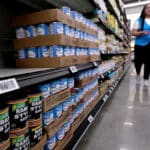
For a while, when your favorite products were hard to find and coupons and sales were even rarer, many shoppers abandoned their usual savings strategies and just bought their groceries wherever regular prices were the lowest. But just as grocery supplies and sales are returning to normal, inflation means “everyday low prices” aren’t as low as they used to be. As a result, more shoppers are looking for coupons and deals again.
That’s one of the findings in the retail analytics company dunnhumby’s latest Consumer Pulse Survey, which has tracked the impact of COVID-19 on consumer attitudes and behavior ever since the pandemic began. Overall, the good news/bad news in the survey is that “U.S. consumers are now more worried about rising food prices, the economy, and their own personal finances than they are with getting COVID.” So they’re more comfortable going grocery shopping in person again without fear of infection – but now they’re looking for more serious ways to save.
dunnhumby found that more shoppers are using coupons and seeking out sales than at any time since it began conducting its coronavirus-era surveys in 2020. 41% said they use coupons on products they regularly buy, and 37% search online for the best sales before they go grocery shopping. Both of those percentages have been creeping upward over the past couple of years. In contrast, the percentage of shoppers who say they are “shopping at stores with the lowest prices” has been declining – 36% now do so, as compared to 55% who did last fall, and 58% back in 2020. Buying store brands as a savings strategy is also declining slightly in popularity, with 31% saying they do so, as compared to 33% who said so throughout 2020 and into early 2021.
Interestingly, shoppers identified as “value seekers,” who use two or more value behaviors like using coupons or seeking out the lowest prices, are more likely to get stuck in something of a feedback loop when it comes to their concerns about prices. Inflation is causing them to seek out ways to save money, but they’re also more likely to overestimate just how bad inflation is, which then causes them to become even more intent on seeking out more ways to save money. While the actual food inflation rate stands at 7.4%, “value seekers” in dunnhumby’s survey estimated that the rate was actually 18.4%.
That percentage was lower among non-value seekers, but still much higher than the actual inflation rate. “The perception of what the increase is far exceeds the reality,” dunnhumby’s report reads. Nevertheless, it warned, “perception is reality.”
“We need to revise our thinking about how consumers consider inflation,” dunnhumby North American President Grant Steadman said in a statement. “Americans’ belief that food prices are rising more than twice as fast as they actually are should concern retailers, manufacturers and the government alike.”
As prices rise, some manufacturers have consoled themselves by looking at their sales figures and concluding that shoppers don’t seem to mind paying more. Procter & Gamble, for one, which makes some of the priciest but most popular brands, said a couple of months ago that higher prices haven’t seemed to affect customer behavior much. Shoppers “continue to prefer P&G brands and the superior performance they provide even as inflation is impacting household budgets,” a company executive said.
dunnhumby is warning manufacturers and retailers against complacency. “Likely, we have not yet seen the full extent of how consumers will react to food price increases,” Steadman said.
51% of shoppers now say their money doesn’t go as far it used to when shopping, another all-time high in dunnhumby’s survey, up from just 29% a year ago. 83% think food prices have gone up, with half saying they have gone up a lot.
So marketers who believe they can raise prices, cut back on coupons and have fewer sales without affecting customer behavior, may find that shoppers have other ideas. With interest in coupons and deals perking up, those who don’t offer them may find that shoppers are switching to retailers and brands that do.















